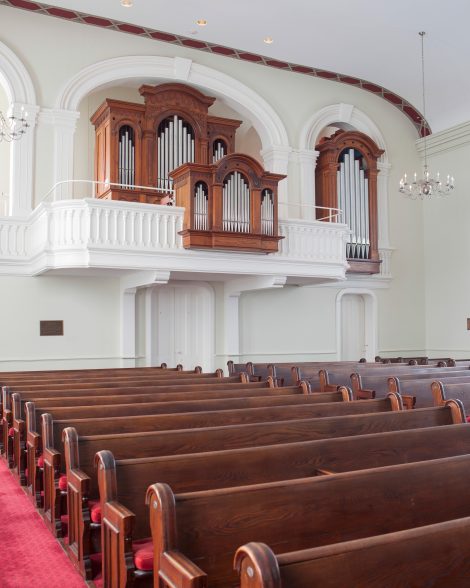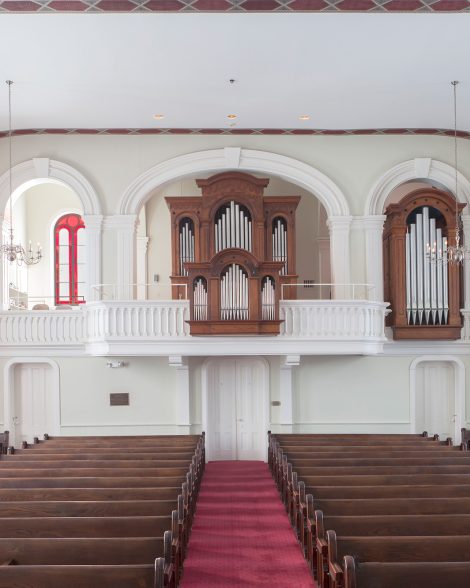Opus 70
First Presbyterian Church
Cazenovia, NY
View Site
“Unique circumstances have brought about a unique organ for this church. Although the present edifice was built in 1806, it was extensively—and tastefully—rebuilt sixty-two years later in a style which is only now coming to be understood and appreciated. As organ builders, we could have placed here a contemporary organ design, or even an 1806 organ design. It seemed to us fitting, however, that we work within the style imposed so successfully on the church in the late 1860’s, particularly since we could see how the organ’s and choir’s practical needs would lead to a charming superposition of Italianate arches and motifs, such as would overjoy the staunchest Victorian. Besides, the old organ we found here, built in Utica in 1869 by the Englishman John Marklove, possessed certain admirable qualities. It seemed right, somehow, to honor Marklove’s point of view along with that of the church builders.
“The Marklove organ was stifled by the arcade above the gallery. By extending the central section of gallery somewhat over the heads of the congregation we were enabled to bring Marklove’s old Chestnut case to the front of the arcade and to house the new Great division within it. A new, diminutive case in Marklove’s style adorns the balcony rail center and houses the new Choir, or Rückpositiv, division. To the right, located asymmetrically, is the new Pedal Tower containing the largest pipes in the organ. Because Chestnut wood has been unavailable since the great Chestnut blight, both new cases are made of Chestnut wood removed from Old Saint Mary’s Church in Boston’s North End. A detached keydesk in Mahogany occupies the center of the new balcony space and places the organist in direct communication with both organ and choir.
“The tonal design…is unabashedly eclectic, the theory behind it being that an excellent church organ will result if only good placement, good voicing and tracker key action are present. The Great division is in a Swell box, an unusual juxtaposition that gives flexibility for accompanying the choir and for performing certain pieces of the Romantic organ literature. Performance of this literature is also enhanced by certain softer stops included in the Great. Meanwhile, flexible winding—especially in the Choir division—makes for an authentically Baroque sound.
“This organ…has its own personality, its own pleasurable aspects, its own way of showing sadness or joy or anger…”
Charles Fisk, 1976
Great (enclosed)
Stillgedackt 16′ *
Prestant 8′
Chimney Flute 8′ *
Gambe 8′
Voix céleste 8′
Octave 4′
Wedge Flute 4′
Doublet 2′
Cornet III
Mixture IV-VI
Trumpet 8′
Hautboy 8′ *
Choir (Rückpositiv)
Bourdon 8′ *
Principal 4′
Night Horn 4′
Nazard 2 2/3′
Prestant 2′
Tierce 1 3/5′
Larigot 1 1/3′
Sharp IV
Cremona 8′
Pedal
Principal 16′ *
Flûte 8′
Superoctave 4′ *
Bassoon 16′
Trumpet 8′
Great to Choir
Choir to Great
Great to Pedal
Choir to Pedal
Tremulant
Cymbal Star
Manual keyboards, CC-g3 56 notes, concave radiating Pedalboard, CC-f1 30 notes
Key action is mechanical, stop action is electro-pneumatic.
Great is enclosed behind shades controlled by a balanced swell shoe.
Detached console.
* Pipework from pre-existing Marklove organ, rebuilt and revoiced.

Opus 70
First Presbyterian Church
Cazenovia, NY
View Site:
Independent voices: 26
Ranks: 36
Created: 1976
“Unique circumstances have brought about a unique organ for this church. Although the present edifice was built in 1806, it was extensively—and tastefully—rebuilt sixty-two years later in a style which is only now coming to be understood and appreciated. As organ builders, we could have placed here a contemporary organ design, or even an 1806 organ design. It seemed to us fitting, however, that we work within the style imposed so successfully on the church in the late 1860’s, particularly since we could see how the organ’s and choir’s practical needs would lead to a charming superposition of Italianate arches and motifs, such as would overjoy the staunchest Victorian. Besides, the old organ we found here, built in Utica in 1869 by the Englishman John Marklove, possessed certain admirable qualities. It seemed right, somehow, to honor Marklove’s point of view along with that of the church builders.
“The Marklove organ was stifled by the arcade above the gallery. By extending the central section of gallery somewhat over the heads of the congregation we were enabled to bring Marklove’s old Chestnut case to the front of the arcade and to house the new Great division within it. A new, diminutive case in Marklove’s style adorns the balcony rail center and houses the new Choir, or Rückpositiv, division. To the right, located asymmetrically, is the new Pedal Tower containing the largest pipes in the organ. Because Chestnut wood has been unavailable since the great Chestnut blight, both new cases are made of Chestnut wood removed from Old Saint Mary’s Church in Boston’s North End. A detached keydesk in Mahogany occupies the center of the new balcony space and places the organist in direct communication with both organ and choir.
“The tonal design…is unabashedly eclectic, the theory behind it being that an excellent church organ will result if only good placement, good voicing and tracker key action are present. The Great division is in a Swell box, an unusual juxtaposition that gives flexibility for accompanying the choir and for performing certain pieces of the Romantic organ literature. Performance of this literature is also enhanced by certain softer stops included in the Great. Meanwhile, flexible winding—especially in the Choir division—makes for an authentically Baroque sound.
“This organ…has its own personality, its own pleasurable aspects, its own way of showing sadness or joy or anger…”
Charles Fisk, 1976
Great (enclosed)
Stillgedackt 16′ *
Prestant 8′
Chimney Flute 8′ *
Gambe 8′
Voix céleste 8′
Octave 4′
Wedge Flute 4′
Doublet 2′
Cornet III
Mixture IV-VI
Trumpet 8′
Hautboy 8′ *
Choir (Rückpositiv)
Bourdon 8′ *
Principal 4′
Night Horn 4′
Nazard 2 2/3′
Prestant 2′
Tierce 1 3/5′
Larigot 1 1/3′
Sharp IV
Cremona 8′
Pedal
Principal 16′ *
Flûte 8′
Superoctave 4′ *
Bassoon 16′
Trumpet 8′
Couplers:
Great to Choir
Choir to Great
Great to Pedal
Choir to Pedal
Accessories:
Tremulant
Cymbal Star
Manual keyboards, CC-g3 56 notes, concave radiating Pedalboard, CC-f1 30 notes
Key action is mechanical, stop action is electro-pneumatic.
Great is enclosed behind shades controlled by a balanced swell shoe.
Detached console.
* Pipework from pre-existing Marklove organ, rebuilt and revoiced.



